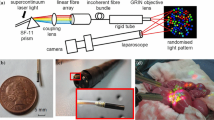Abstract
This paper presents an algorithm that automatically detects and corrects specular reflections in thoracoscopic images and its application in the context of automatic segmentation of surgical tools. The detection is done by isolating the spike component of the specular reflection which is characterized by a bump at the end of the histogram of thoracoscopic images. The specular lobe is then extracted in the neighborhood of the spike component of the reflection. The result is a mask of the reflections positions in the image. Thereafter, the image is corrected using Oliveira et al.’s digital inpainting method. The automatic segmentation of surgical tools using the corrected images is then demonstrated. Results of the segmentation with and without the specular reflection elimination technique are compared. Moreover, 108 images extracted from 5 different surgeries performed under various conditions were considered to demonstrate the effectiveness of the proposed technique.
Similar content being viewed by others
References
Bertalmio, M., Sapiro, G., Caselles, V., Ballester, C.: Image inpainting. In: Akeley, K. (Ed.) Siggraph 2000, Computer Graphics Proceedings, pp. 417–424. ACM Press/ACM SIGGRAPH/Addison-Wesley Longman (2000). http://citeseer.ist.psu.edu/bertalmio00image.html
Bochko, V., Miyake, Y.: Highlight removal in endoscope images. In: Proceedings of CGIV, pp. 167–171 (2006)
Boisvert, J., Cheriet, F., Grimard, G.: Segmentation of laparoscopic images for computer assisted surgery. In: Image Analysis, 13th Scandinavian Conference, SCIA 2003, pp. 587–594 (16 June–2 July 2003)
Deng Y. and Manjunath B. (2001). Unsupervised segmentation of color-texture regions in images and video. IEEE Trans. Pattern Anal. Mach. Intell. 23(8): 800–810
Donoho D.L. and Johnstone I.M. (1994). Ideal spatial adaptation by wavelet shrinkage. Biometrika 81(3): 425–455
Thongtrangan I., Le H. and Park J. (2004). Minimally invasive spinal surgery: a historical perspective. Neurosurg. Focus 16(1): E13
Lin, S.: Generation of diffuse and specular appearance from photometric images. In: Workshop on Photometric Modeling for Computer Vision and Graphics, pp. 39–46 (1999)
Ma, K.K., Wang, J.: Color distance histogram: a novel descriptor for color image segmentation. In: Proceedings of International Conference on Control, Automation, Robotics and Vision, vol. 3, pp. 1228–1232 (2002)
Mallat S. (1999). A Wavelet Tour of Signal Processing. Academic, San Diego
Masnou, S.: Disocclusion: a variational approach using level lines. In: IEEE Transactions on Image Processing, vol. 11, Issue 2, pp. 68–76 (2002)
Masnou, S., Morel, J.: Level lines based disocclusion. In: International Conference on Image Processing, vol. 3, pp. 259–263 (1998). http://citeseer.ist.psu.edu/masnou98level.html
Okatani, T., Deguchi, K.: Reconstructing shape from shading with a point light source at the projection center: shape reconstruction from an endoscope image. In: Pattern Recognition, Proceedings of the 13th International Conference on, vol. 1, pp. 830–834 (25–29 August 1996)
Oliveira, M., Bowen, B., McKenna, R., Chang, Y.: Fast digital image inpainting. In: Proceedings of the International Conference on Visualization, Imaging and Image Processing, pp. 261–266 (2001)
Park, J.B.: Detection of specular highlights in color images using a new color space transformation. In: Proceedings of IEEE International Conference on Robotics and Biomimetics, pp. 737–41 (2004)
Shafer S.A. (1985). Using color to separate reflection components. COLOR Res. Appl. 10(4): 210–218
Torres, F., Angulo, J., Ortiz, F.: Automatic detection of specular reflectance in colour images using the ms diagram. In: Lecture Notes in Computer Science, vol. 2756, pp. 132–139 (2003)
Vapnik V. (1995). The Nature of Statistical Learning Theory. Springer, Heidelberg
Vogt, F., Paulus, D., Heigl, B., et al.: Making the invisible visible: highlight substitution by color light fields. In: Proceedings of the First European Conference on Colour in Graphics, Imaging, and Vision, pp. 352–357 (2002)
Windish, L., Cheriet, F., Grimard, G.: Bayesian differentiation of multi-scale line-structures for model-free instrument segmentation in thoracoscopic images. In: Kamel, M., Ampilho, A. (Eds.) Second International Conference ICIAR 2005, pp. 938–948. LNCS, vol. 3656 (2005)
Wolff, L.B.: On the relative brightness of specular and diffuse reflection. In: Proceedings of CVPR, pp. 369–376 (1994)
Xu, S.C., Ye, X., Wu, Y., Zhang, S.: Highlight detection and removal based on chromaticity. In: Proceedings of ICIAR 2005, pp. 199–206 (2005)
Author information
Authors and Affiliations
Corresponding author
Rights and permissions
About this article
Cite this article
Saint-Pierre, CA., Boisvert, J., Grimard, G. et al. Detection and correction of specular reflections for automatic surgical tool segmentation in thoracoscopic images. Machine Vision and Applications 22, 171–180 (2011). https://doi.org/10.1007/s00138-007-0099-6
Received:
Accepted:
Published:
Issue Date:
DOI: https://doi.org/10.1007/s00138-007-0099-6




